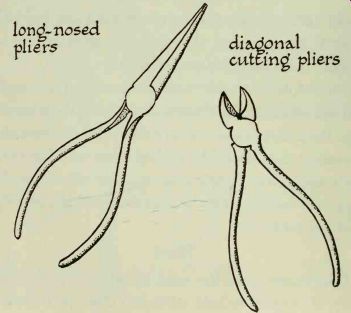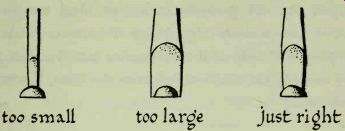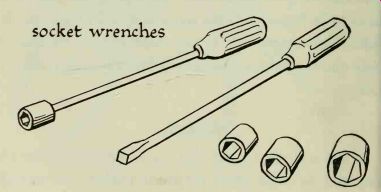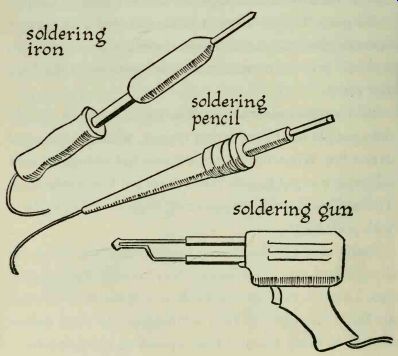TOOLS
Every craft requires the use of certain tools, and radio work is no exception. An elaborate workshop is not needed, but a few tools are essential.
Good tools are a wise investment, so buy the best that you can afford. Never abuse tools by using them improperly. Keep them clean and dry. Should they show signs of rusting, they should be rubbed clean with fine emery cloth and coated lightly with machine oil. If possible, keep your tools in a rack or store them in a drawer when they are not in use.
Pliers
Long-nosed pliers are used by all radio technicians.
They are needed to hold wires and other parts that are being soldered and to bend wires into desired shapes.
They should not be used for heavy work, such as tightening large nuts or bending nails and bolts. Think of this tool as an extension of your fingers that enables you to reach otherwise inaccessible places.
Diagonal cutting pliers are used to cut wires. There are many other types of cutting pliers, but they are mostly used for heavy-duty work. Diagonals have slim jaws and can be used in tight spots. Use them only on wire, never on nails or bolts, for the cutting edge can be nicked very easily.

-----

---------- Screwdrivers
Screwdrivers used in radio or electrical work should have insulated handles, usually made of plastic or hard rubber. They are made in several different sizes. The size you will need for a particular job will depend upon the size of the slot in the head of the screw or bolt that is to be tightened. The end of the screwdriver should just fit into the slot it engages. If it is too small it will mutilate the screw head, leaving sharp bits of protruding metal that can be quite hazardous. One that is too large will have to be forced into the screw slot, with the same results. The experiments in this guide require the use of only one screwdriver; be sure it fits the screws you are using.
Penknife
Wires and other parts that are to be soldered or are required to make good electrical contact are usually scraped. An old penknife makes an ideal scraper; it needn't have a sharp edge. Never use a razor blade for scraping. Not only is it a dangerous practice, but you may remove too much metal from the wire, leaving it weakened.
Socket Wrenches
Socket wrenches are used to tighten nuts. They may be purchased singly or in sets of assorted sizes. As the name implies, this tool consists of a socket, which is; attached to a handle. The socket is slipped over the nut and the handle is turned like that of a screwdriver. Some sets consist of one handle with interchangeable sockets..
You simply select the socket that fits the nut to be tightened, then fasten it to the handle by pressing it into place.

-------------
Socket wrenches are not essential, but they will make your work easier. If you do not have any, you can still tighten nuts and bolts very simply. Slip the nut over the bolt and turn it as far as you can with your fingers. Grasp the nut with a large pair of pliers, then use a screwdriver to turn the bolt the rest of the way.
HOW TO SOLDER
Solder is an alloy of lead and tin. It melts very readily and is used to fasten together wires and other metal radio parts. Do not attempt to do this with any type of cement, glue, or paste. These materials are insulators, and will prevent current from flowing through the joint you make.
Soldering requires the application of heat. In the old days people used a soldering copper, which was heated over a fire. When the copper became hot enough to melt solder, it was put to use. When it cooled it was reheated.
Tinsmiths still use large soldering coppers, heating them with portable torches.
Radio men use electrically heated soldering irons. Al though they are called "irons," they actually have copper tips. They are made in many different types and sizes and are rated according to their wattage, or electrical power needed to bring them to their operating temperature.
Very small electric irons are known as soldering pencils. These have fine tips and are excellent for delicate work. They consume very little power; a 15-watt pencil will do most soldering jobs. Many soldering pencils have interchangeable tips. When one wears out, it can be re moved with a pair of pliers and a new one can be substituted. Some pencils consist of a handle into which heating units of different sizes can be screwed; these can be purchased separately.

----
Soldering is also done with an electric soldering gun.
Such guns are usually made with a pistol grip so that they can be handled easily. Pressing a switch causes current to flow through a built-in transformer, and the gun is brought to operating temperature in a matter of seconds.
As soon as the joint is soldered, pressure on the switch is released and the gun is allowed to cool.
Not all metals can be soldered. Radio work usually calls for soldering copper or tinned surfaces, and this can be done very easily. Do not try to solder aluminum, as this cannot be done with ordinary soldering equipment; special types of solder must be used.
Solder is manufactured in different forms. Bar solder and solid wire solder are used by plumbers and tin smiths. Neither one of these is suitable for our purpose.
Rosin-core solder is the only type recommended for electrical connections. This is made in the form of a hollow wire, the inside of which contains rosin. The rosin serves an important purpose: it acts as a flux which keeps the joint clean as it is being soldered. The heat of the soldering iron causes metals to tarnish, or form an oxide very quickly. This coating or discoloration will prevent the solder from flowing and forming a good joint. Flux dissolves the oxides and makes soldering possible.
Never use acid-core solder. This is a type of hollow-wire solder in which acid is used as a flux. It will enable you to make a good soldered joint, but the acid will eventually cause corrosion.
Soldering involves more than just applying heat. Follow these steps for good results:
(1) All surfaces that are to be soldered must be clean.
Tarnish and dirt must be removed, otherwise the solder will not adhere. Brighten the metal by scraping it with a knife blade or rubbing it with sandpaper, emery cloth, or steel wool.
(2) Parts to be joined by soldering must make good contact. Wires should be twisted together. When soldering a wire to a larger surface, hold it in place with long nosed pliers. Do not try to fill gaps between wires and other parts with solder.
(3) A new soldering iron must be tinned. This consists of coating the tip with a layer of melted solder.
First, scrape or sandpaper the tip until it is clean and shiny. Plug in the iron and allow it to become hot enough to melt a bit of solder that is touched to it. Run melted solder all over the tip of the iron, then wipe it on a clean rag; this will remove any excess solder, leaving a thin, even coating. After an iron has been tinned, it is simply heated each time it is to be used.
(4) Touch the hot, tinned iron to the joint that is to be soldered. Then bring the end of the wire solder into con tact with both the iron and the joint. The solder will melt at once. Quickly remove the solder, but keep the hot iron in place for a moment; this allows the solder to flow around the joint. It also gives the flux a chance to boil off.
Never make a soldered joint by touching the solder only to the hot iron; this may result in a "cold" joint. The solder will melt but may not adhere properly to the metal parts that are to be joined.
(5) After you have removed the iron from the soldered joint, allow the solder to "set," or harden, before you touch or disturb it in any way.
Use as little solder as possible. A joint that has been properly soldered has a bright, shiny appearance. If it looks dull or slightly rough, reheat it until the solder flows freely again.
Some radio parts have wire leads (pronounced "leeds"), or "pigtails," by means of which they are soldered into circuits. Excessive heat applied to these leads may be conducted to the part itself, causing damage. When soldering such parts, grip the wire lead with long-nosed pliers, just above the point you are soldering. Heat from the soldering iron will be absorbed by the plier tips, and will be prevented from passing along the wire to the part.
WIRE
Wire is manufactured in different sizes, which are identified by gage numbers. The number of a wire refers to its diameter, or thickness; the higher the number, the thinner the wire.
Insulated wire is always used in radio construction.
This is important, otherwise wires might touch at the wrong places and cause short circuits. Some commonly used insulating materials are rubber, plastic, and braided cotton covering.
Most people use hookup wire for circuit wiring. This wire may consist of a single, solid wire or it may be made up of separate wire strands twisted together. Stranded wire is more flexible and can be twisted and bent many times before breaking. On the other hand, solid-conductor wire is less expensive and easier to handle. Hook up wire is always tinned, and it need not be scraped before it can be soldered.
The end of an insulated wire must be bared before it is fastened in place in a circuit. Use your penknife to cut lightly through the insulation all around the wire. Hold the blade at an angle, so that the sharp edge faces the end of the wire. If you hold the knife blade at a right angle to the wire, you may cut through the insulation and nick the wire; this will cause it to break the first time it is bent. Using diagonal pliers, grasp the insulation below the point you have cut, then pull it free.
The easiest type of hookup wire to use is push-back wire. No cutting is necessary. In order to bare the end of the wire, simply push the insulation back with your fingers.
Magnet wire is used for winding coils. It may be purchased in spools weighing 3/4 pound or 1 pound. Sizes 24 to 32 magnet wire may be used for all the experiments described in this guide. You can also use it instead of hookup wire in constructing our low-powered circuits.
Magnet wire is usually insulated with enamel or plastic coating or cotton wrapping. Coated wires take up less winding space than wrapped wires and make smaller coils. A penknife, sandpaper, emery cloth, or coarse steel wool can be used to remove coated insulation from wires.

---------- cut into insulation